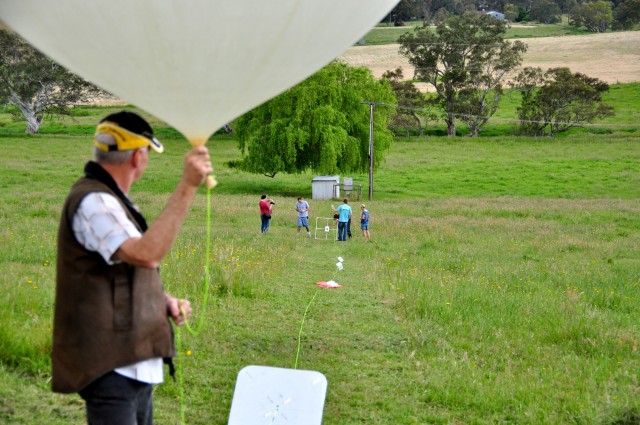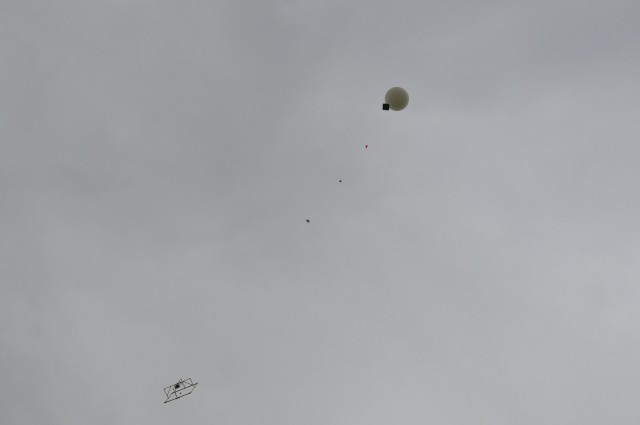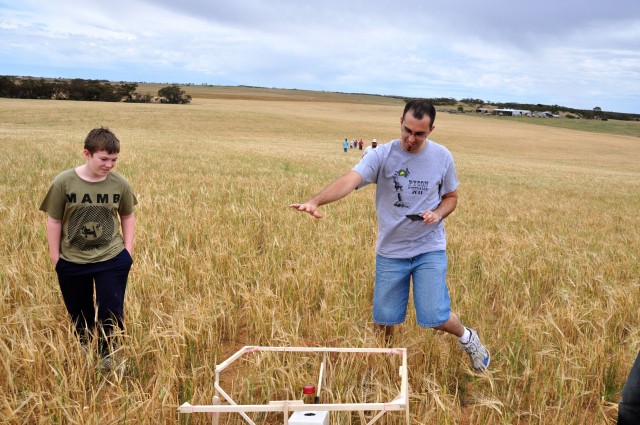Horus 18
Technical information:
| Launch date | 13/11/2011, 09:44 am |
| Landing date | 13/11/2011, 12:37 pm |
| Flight duration | 2 hours, 53 minutes |
| Launch site | -35.1020, 138.8253 |
| Landing site | -35.2773, 139.9956 |
| Flight path | Web, KMZ |
| Distance travelled | 108.3 km |
| Maximum altitude | 33,243 m |
| Average ascent rate | 5 m/s |
| Impact speed | 5 m/s |
| Flight computer | MicroNut Flight Computer, MicroNut APRS Tracker |
| GPS module | uBlox 6 NEO-6Q + Sarantel GeoHelix antenna |
| Radio transmitter | Radiometrix NTX2 25mW (RTTY), Radiometrix HX1 300mW (APRS) |
| Telemetry | 300 baud RTTY, CRC16 checksum & APRS |
| Video Cameras | GoPro HD Hero, 3x MD80 Spy Cams |
| Tracking | Ground stations (distributed listener), 3 chase cars, web based tracker, APRS network |
Details:
Horus 18 was a promotional video launch for the guys over at YoYoShop, as well a chance for us to test Mark's Micronut payload in APRS configuration & our shiny new uBlox 6 GPS modules.

Preparation and Launch:
It was mostly familiar faces at the Horus 18 launch site, though we did have a couple of guests along to see what we get up to in our spare time - Phil and his son Riley were there for the launch and also came along for the chase.
With plenty of hands on deck, preparation went quickly and smoothly - we were lucky to have perfectly still air which made launching an absolute breeze, even with the large payload assembly.
Moments after we launched, we were treated to a light sprinkling of rain - fortunately this didn't seem to affect our primary video camera (though it did show up in the video).
A few computer issues did crop up with our offline tracking software early in the piece, but these were quickly quashed - leaving us to get on with more interesting things.
Flight & Recovery:
From release to landing the flight of Horus 18 went exactly as planned - a smooth 5m/s ascent rate & strong telemetry (both on RTTY and APRS) combined with an easy to follow flight path made for an issue free chase.
After initially racing ahead at ~150km/h above us, the balloon slowed down and turned around once it reached Tailem Bend, allowing us to catch up & then overtake it. After a quick stop for food & some strategy talk at the Tailem Bend servo, we headed off towards Sherlock (close to the expected landing).
Our expected burst altitude of 30km came and went - the balloon climbed until it reached 33.2km, slightly shifting the landing prediction. Once the balloon had burst, our chase teams split up to cover more ground & get into position around the expected landing site (north of Peake).
It looked almost certain at this point that Horus 18 would land in a patch of dense scrub - 2 of our chase teams ended up on the edge of a reserve watching the payload descend the last few hundred meters, finally taking a turn away from the scrub just before touchdown to land in a field of wheat.
Despite a soft landing, the large parachute used on Horus 18 meant that the payload was dragged along the ground for some distance, resulting in damage to the lightweight balsa wood frame used in the video rig.
Conclusions:
Despite the rain sprinkle (which is thought to have knocked out the 3 MD80 cameras early in the flight), Horus 18 was a great success. All systems functioned exactly as planned, and we managed to get some great footage - including payload descent.
A big thanks to the excellent ham turnout who assisted with tracking on the day! ![]()



















